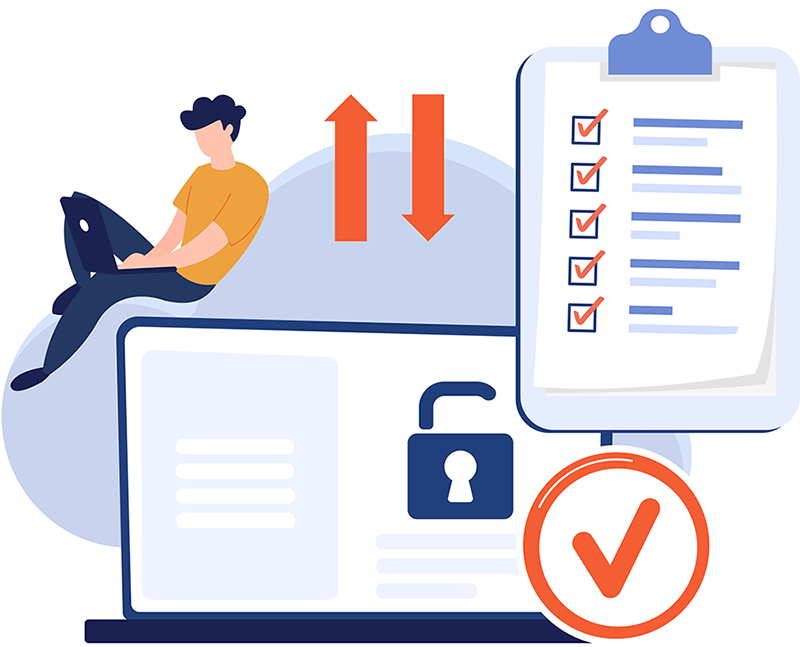
Within the intricate tapestry of corporate operations, the ever-present specters of security risks, threats, and challenges weave a daily narrative for every company. While these terms might be casually conflated, their subtleties carry profound implications. Understanding the nuances distinguishing them is paramount to fortifying your cloud assets.
To illuminate the distinctions:
- Risks: The dormant volcano
Like a dormant volcano, risks lie beneath the surface, embodying the latent potential for data loss or vulnerability exposure.
- Threats: Prowling shadows
Like prowling shadows, threats materialize as tangible entities or specific attacks within the cybersecurity landscape.
- Challenges: The labyrinth
Challenges in cloud security are comparable to navigating a labyrinth, involving intricate hurdles for organizations.
Imagine, for instance, an API endpoint suspended in the cloud’s ethereal expanse, exposed to the public Internet. This metaphysical bridge poses a risk akin to the delicate tension preceding a storm. The malevolent actor attempting to breach sensitive data through this API is the threat, an elusive phantom armed with various techniques. Meanwhile, the organization grapples with preserving the sanctity of public APIs while extending an accommodating hand to legitimate users or customers.
A comprehensive cloud security symphony harmoniously orchestrates these three dimensions, ensuring no dissonant cracks mar the foundation. Picture each aspect as a unique lens, casting light on diverse facets of cloud security. A resilient strategy must deftly compose security controls to temper risks, execute a secure coding and deployment pas de deux to thwart threats, and choreograph cultural and technical solutions to pirouette past challenges. This multifaceted choreography secures the stage for your business, allowing it to pirouette and flourish securely within the dynamic landscape of the cloud.
Navigating cloud security challenges
In the intricate landscape of cloud security, the journey involves acknowledging that eliminating risk is a noble aspiration. However, the absolute mastery lies in adept risk management. Anticipating potential hurdles equips you with the foresight needed to handle them within your specific operational environment. So, what are the distinctive risks intertwined with cloud security?
Human oversight
Gartner’s foresight unveils a staggering prophecy. By 2025, 99% of cloud security lapses will find their roots in various shades of human error. Crafting business applications inherently dances with the risk of accidental human missteps. The stakes are significantly heightened when these digital realms reside within the public cloud. The user-friendly allure of the cloud often tempts individuals into deploying APIs without the watchful gaze of proper controls, birthing vulnerabilities within your security tapestry. The remedy for human error lies in constructing robust controls and guiding users toward informed decisions. Shift the focus from assigning blame to individuals and redirect it towards refining processes and erecting guardrails to foster an inherently secure ecosystem.
Data’s perilous journey
A data breach unfurls its ominous wings when sensitive information slips away from your guardianship without consent or awareness. Data emerges as the holy grail for cyber assailants, making it the prime target in their digital escapades. Cloud misconfigurations and the absence of robust runtime protection fashion the perfect storm, inviting malicious entities to snatch this coveted data. The repercussions of a data breach undulate depending on the nature of the purloined data.
- Personally identifiable information (PII) and personal health information (PHI) are exploited as valuable assets on the dark web, contributing to identity theft and phishing activities.
- Internally, sensitive documents and emails can be weaponized to damage a company’s reputation or manipulate stock prices.
- Businesses relying heavily on cloud services face a significant and ever-present threat from data breaches.
- The illicit use of PII and PHI in underground markets underscores the importance of implementing secure handling practices.
- Compromised internal documents have far-reaching consequences, impacting a company’s public perception and financial stability.
- Businesses must prioritize robust security measures to safeguard personal and corporate information to mitigate risks.
- Taking a proactive approach to cybersecurity is essential in adapting to and defending against evolving threats affecting individuals and organizations.
Misconfiguration
The expanding repertoire of cloud services offered by diverse providers unveils a distinct challenge – misconfiguration. Each provider sports its unique default configurations, with every service boasting distinctive implementations and quirks. As organizations grapple with the intricacies of securing many cloud services, adversaries seize opportunities birthed by misconfigurations. Until proficiency is attained in securing this diverse tapestry of cloud services, misconfigurations will linger as an inviting vulnerability. As the dynamic dance of cloud settings evolves, companies juggling multiple providers must maintain unwavering vigilance and proactive measures to address misconfigurations, fortifying their security stance.
In the orchestration of cloud security, the art lies not in the complete eradication of risk but in the elegant navigation and proactive management of these intricacies. Grasping these potential challenges empowers organizations to weave a resilient defense, enabling them to traverse the dynamic landscape of cloud computing securely and uniquely.
Unmanaged exposure to potential threats
The term “attack surface” refers to the overall vulnerability of your environment. The integration of microservices has the potential to significantly increase the amount of publicly accessible workloads within your system. Each added workload contributes to the overall attack surface. Without vigilant management, it is possible to unintentionally expose your infrastructure in ways that may only become apparent during an actual security breach. The consequences of such an oversight can be dire, as exemplified by the undesirable scenario of receiving a late-night call due to a security incident. Moreover, the attack surface extends beyond apparent vulnerabilities. It can encompass subtle information leaks that may be exploited in an attack.
To ensure the security of cloud-based systems, consider the following recommendations:
1. Conduct routine risk assessments to identify emerging risks and vulnerabilities.
2. Prioritize and implement security controls to mitigate the identified risks effectively. If needed, seek assistance from security experts.
3. Document and periodically review any consciously accepted risks, ensuring a comprehensive understanding of the associated implications and potential consequences.
Cloud security threat landscape
Within cloud security, threats materialize as intentional assaults on your assets, exploiting inherent risks. Here are four distinctive threats encountered in the realm of cloud security:
Sophisticated persistent threats (SPTs):
An SPT represents a highly refined and protracted cyberattack, where an infiltrator clandestinely establishes a presence within a network, aiming to exfiltrate sensitive data over an extended period.
Characteristics: Diverging from opportunistic attacks, SPTs methodically navigate through workloads, systematically seeking valuable information for eventual illicit transactions. These attacks typically commence with the deployment of zero-day exploits, remaining undetected for extended durations.
Internal menace dynamics:
The internal menace dynamic encapsulates cybersecurity risks from within the organization, often posed by current or former employees or individuals with direct access to the company network, sensitive data, and intellectual property (IP).
Characteristics: These threats prove elusive, as perpetrators possess insights into the organization’s systems, processes, and policies, making detection a nuanced challenge and leveraging internal knowledge.
Zero-hour vulnerabilities:
Despite the cloud operating on “someone else’s computer,” the persistent use of computing systems and software, even within another organization’s data center, exposes vulnerabilities to zero-hour exploits.
Characteristics: Zero-hour exploits target unpatched vulnerabilities in popular software and operating systems. Even with a meticulously configured cloud environment, these exploits introduce risks by granting unauthorized access to the cloud infrastructure.
Digital onslaught tactics:
Digital onslaught tactics involve deliberate endeavors by cybercriminals, hackers, or digital adversaries to breach a computer network or system to manipulate, steal, eradicate, or expose information.
Common manifestations include malware propagation, sophisticated phishing schemes, Denial of Service (DoS) and Distributed Denial of Service (DDoS) attacks, SQL injections, and exploits rooted in the Internet of Things (IoT).
Managing cloud security threats: best practices
Effectively addressing the multitude of specific attacks poses a considerable challenge in safeguarding cloud infrastructure. However, the following three guidelines can serve as crucial measures to protect your cloud assets from a variety of threats:
- Adhere to secure coding standards during the development of microservices.
- Thoroughly review and validate your cloud configuration to identify and rectify any vulnerabilities.
- Establish a secure foundation and proactively engage in threat hunting to bolster your defensive capabilities.
Challenges in cloud security
Addressing the challenges in cloud security often involves bridging the gap between theoretical knowledge and practical implementation. While recognizing the importance of having a cloud security strategy, it becomes crucial to determine the starting point, approach cultural change, and delineate the daily practical steps required to bring this strategy to fruition.
Identity and access management:
Mastering Identity and Access Management (IAM) is a critical puzzle in cloud security. While acknowledging its significance, the real challenge unfolds in the intricate implementation details. Crafting a holistic IAM strategy involves a nuanced three-step dance: kick off with a robust role design, not bound by any specific IAM system; choreograph a Privileged Access Management (PAM) strategy to safeguard roles with heightened privileges; and execute the meticulously designed roles within the chosen cloud provider’s IAM service. This choreography ensures a well-orchestrated symphony of access definition, privilege control, and seamless implementation.
Cloud security acumen gap:
Stepping into the cloud requires shedding the cloak of traditional data center security models and donning a new, cloud-tailored attire. The challenge lies in equipping administrators with the knowledge and skills befitting this dynamic environment. This know-how is necessary to prevent organizations from vulnerabilities, especially in understanding the intricacies of the shared responsibility model. It is imperative to meticulously plan, ensuring a harmonious alignment of security measures with the distinctive challenges introduced by cloud computing.
Navigating the compliance cloud:
Navigating the regulatory landscape in the cloud becomes complex, with moves dictated by standards like PCI DSS and HIPAA to protect sensitive data. Organizations often tighten the reins on access to stay compliant and meticulously define user permissions. Without robust access controls, monitoring network access becomes a regulatory tightrope walk. Crafting a comprehensive access management strategy emerges as a pivotal act, ensuring a consistent performance that adheres to regulatory obligations without missing a step.
Shadow IT unveiled:
The enigma of Shadow IT casts a veil over standard IT protocols, challenging security by sidestepping the traditional approval and management processes. As agile soloists, employees often turn to independent cloud services, birthing an uncontrolled crescendo in resource usage. This decentralized symphony births assets that may lack the fortifications of robust security measures, rendering them vulnerable to the melody of default passwords and misconfigurations. Harmonizing security with the swift tempo of DevOps activities becomes the key, necessitating a unified approach allowing for secure application deployment without damaging DevOps’ nimble agility.
Addressing these challenges requires a synchronized ballet between IT, security, and DevOps teams. It is a performance where each player understands their role, allowing for the creation of solutions that resonate with the unique rhythm of the cloud environment while maintaining the speed and grace integral to the art of DevOps.
With the proper knowledge and systems in place, including disaster recovery solutions, cyberattacks can be effectively mitigated, and companies and their customers can feel secure.
Implement disaster recovery measures with Hystax and protect your business, customers, and assets from the threat of ransomware.



